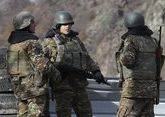The General Directorate of State Archives of the Prime Ministry of the Republic of Turkey published documents denying accusations of the so-called Armenian genocide, which appear on the Armenian Diaspora's agenda every year on April 24-25. The work entitled "The path to resettlement (Based on Archival Documents)" provides information on mass killings committed by Armenian armed forces of the Hnchakists and the Dashnaks.
As Mert Inan writes in the Turkish newspaper Milliyet, 204 original documents were published for the first time, shedding light on the events that were taking place in Anatolia from September 1914 to June 1915. According to documentary evidence, detachments of the Dashnaks and the Hunchaks buried Turkish residents alive. One of the most striking fragments of the book, which was prepared in accordance with documents, is a note dated February 4, 1915, sent by the governor of Erzurum Tahsin Bey to the Ministry of Internal Affairs.
"Buried alive"
Transmitting to the Ministry of Internal Affairs Bahaeddin Shakir Bey's telegram sent from Artvin, the Governor of Erzurum Tahsin Bey informs that members of Greek and Armenian armed forces were burying the Muslims alive near Artvin. From the archive documents it becomes known that the killers transferred to Kars livestock and the products that they took from the Muslim population in the villages, buried the Muslims alive, slashed the fleeing women, children and the infirm. The secret telegram sent to the ministry says: "The village of Kapan reflected an enemy attack,15 enemies were killed, we have three wounded and two dead."
"30 thousand armed Armenians"
The official letter sent by the governor of Sivas Muammer Bey to the Ministry of Internal Affairs on April 21, 1915 says that the Armenian committees have armed 30 thousand Armenians in Sivas, the regions of the uprising were preparing in 16 Armenian villages in Sushahri and in case of the Turkish army's failure they will raise a riot together with other Armenian villages. 15 thousand of 30 thousand armed Armenians joined the Russian army, and the remaining 15 thousand were instructed to surround the troops of the Turkish army from the rear.
"30 thousand men were killed"
An encrypted telegram, sent to the Ministry of Internal Affairs on October 29, 1917 by the governor of Bitlis, provides information about the brutal murder of three gendarmes on the road to Sason: their skulls were broken with an ax, eyes were cut, noses and ears were cut off. The archival documents say that some of the 21 members of the Armenian armed groups that committed the massacre were caught, the killers were taken to Mush and handed over to the military court, while the rest of the criminals hiding in the village of Geligüzanlı were given a week to surrender. It is reported that on the second day of the allotted time the villagers turned those three killers over, while there was no doubt that the revolutionary committee would like to see the the government's position, its measures and conclusions.
The telegram, sent March 21, 1915 from the headquarters of the Caucasian Army to Ahmet Reşit of the Ministry of Foreign Affairs says that Armenian rebels killed 30 thousand Muslim men in Kars and Ardahan. "They burned houses belonging to Muslims, women and children are in distress, the Ottoman prisoners, protection of which was handed over to the Armenians, were subjected to cruel treatment, beaten by rifle butt and killed. The members of the Armenian armed groups deliberately plotted their captivity and then fleet to transmit the information to the Russians, and we need to be cautious," Tahsin Bey wrote.










